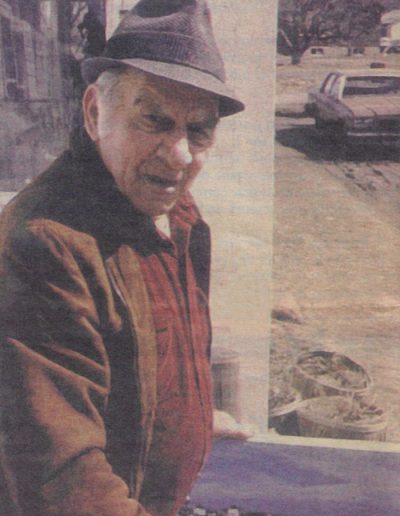Léo B. LeBlanc
The artist and his works
Léo, from a family of eleven children, took on several jobs before devoting himself to painting. He began by working on his father’s land in Notre-Dame, then went to woodcutting sites. In 1940, he began raising poultry, and four years later, he bought a sawmill. Finally, he began breeding Charolais cattle. It was only out of pure pleasure, after watching an artist creating a painting on television, that he began to paint.
His career as an artist took off in 1973 when the Canada Council for the Arts Art Bank purchased four of his works. It was in 1977 that his real notoriety was established, when Premier Richard Hatfield of New Brunswick bought one of his paintings to reproduce it on his official Christmas card. Subsequently, it was his friends, his neighbors and people of great notoriety who appropriated his works. However, one of his paintings – the Village of Maria Chapdelaine – a painting that he dedicated to his wife Léda, will never leave her. When he died, having no children, he bequeathed the collection of works belonging to the family to one of his nieces, Madame Denise Landry. It is she who undertakes the project of perpetuating his memory as a naive/popular Acadian artist.
By instinct and memory, Léo transposes onto his paintings scenes representing lumberjack sites, sugar shacks, pastures dotted with cattle, as well as buildings with particular historical significance, for example the Dysart Hotel. This is how he painted his village Notre-Dame as he remembered it, with its train, with its sawmill and pleasure parties, or smelt fishing in the bays of his region, and and so on. Always, the point of view he adopts in his works results in a wide angle of view, a bird’s eye view.
The art practiced by Léo is part of what the Canadian historian Russell Harper has characterized as vernacular art, the art of the “small world”, in comparison to what we can call “scholarly art” or “academic art”. According to Mr. Bernard Riordon, director of the Art Gallery of Nova Scotia (AGNS),
“Folk art is… an art form that bas emerged from the heart and soul of Canada, free from the trappings of “high art”… it is a spontaneous and tangible extension of the life and experiences of its creator… it is the art of the ordinary person and it reflects a re-visiting of values, a re-examination of the essence of life and a purity of purpose and vision that provides one of the most exciting avenues of visual expression in the world today.”
*(Source: Rapport – Léo B. LeBlanc, le peintre naïf/populaire acadien)


